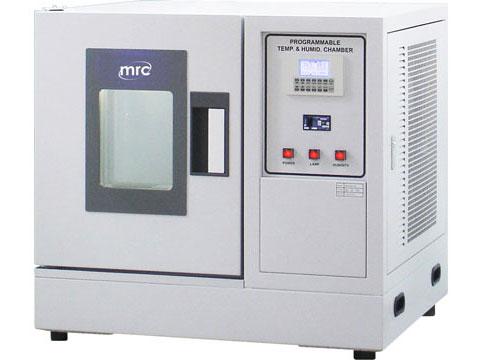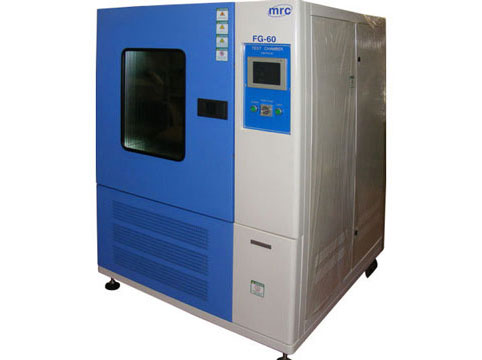MRC environmental test chambers with temperature and humidity control. Chamber Test Humidity and Temperature Programmable humidity and temperature of the range full a simulates freezing, climatic, durability, a reliability test to conditions .etc endurance thermal, assurance quality.
Used Environmental Chambers
Used for testing environmental conditions on biological items,materials,industrial products and electronic devices and more. The test can be done by mechanical processes.Environmental Chamber is a general term for all chambers which simulate temperature or temperature and humidity. Temperature Chambers simulate controlled temperature only. Temperature/Humidity Chambers can simulate both temperature and humidity.
What is a Temperature humidity chamber?
Simulates the effect of temperature and humidity on a particular product. Exposed to external temperature and humidity conditions.
Humidity Chamber
Humidity chamber tests the effect of moisture on the components. It is used in pharmaceuticals, plastic and rubber industries for quality assurance testing. Using a moisture chamber completely improves product reliability and durability.MRC presents humidity chambers in a variety of options and sizes.
How to choose Environmental chamber
When choosing a Humidity chamber you should know the following:
What products are being tested:
Medicines, foods, cosmetics, medical equipment, electronic equipment.
Temperature and humidity working ranges:
- Do you only check the temperature or check temperature and humidity.
-What is the temperature range you need, minimum and maximum.
- What moisture range do you need
Chamber Volume:
What is the size of the inner chamber you need, internal dimensions, volume in liters.
Environmental chamber cooling rate:
What is the cooling rate you need.3 degrees per minute or more?
If you are testing an electronic product that is connected to a mains voltage, check the power dissipated by the tested electronic product.
shelves:
How many shelves do you need.
Controller or programmer:
- Are simple temperature and humidity controllers needed? Or with programmer programs to produce temperature profiles.
- Is there a need for computer communication to write programs and read data online?
TEMPERATURE DATALOGGER
Is a temperature and humidity data logger needed for registration throughout the process?

Industrial And Laboratory Applications Of Humidity Chambers
Several industries test how different weather conditions can affect the physical, chemical, or mechanical state of their assemblies, products, and so on.
In the past, most products were introduced into the market without properly being tested. Nowadays, manufacturers rely on humidity chambers to test their products under several conditions, then use the data generated to improve the product.
The Industries That Use Humidity Chambers Include The Following:
Military
Military hardware, products are tested against rain, extreme heat, wind, and dust. Humidity chambers are used to simulate an extremely moist atmosphere, to generate data about the quality, reliability, and durability of military products.
Rubber
Rubber is easily affected by changes in weather conditions like humidity and temperature.
A humidity chamber is used to test how rubber reacts to 95% humidity, this is done to know the melting, and cracking properties of rubber.
Pharmaceutical
Humidity chambers are essential in this industry for testing the stability of drugs when exposed to certain changes in temperature and humidity.
This is to ensure the safety of consumers Of the drugs.
Plastic
When plastic is exposed to humidity or moisture, it may lead to discoloration, chalking, surface crazing, etc.
Plastic manufacturers always test the tolerance level of their plastics against heat and other weather conditions to determine durability levels.
Electronics
Electrical components are exposed to 60% – 85% humidity, to give the manufacturer data on how the products will fare during shipping, storing, and in extreme operational conditions.
Battery
Battery testing is done to determine the durability of batteries and whether they are prone to corrosion, as well as to determine the overall performance. Batteries are tested in quick succession inside the humidity chamber, so humidity chambers for batteries are built to take over 50 batteries in each testing cycle.
Medical
Medical products are tested under different conditions to ensure the products meet government and industry-set standards and regulations.
Medical products are also tested to determine whether the product will get contaminated or not, and to also determine its shelf life.
Automobile
Manufacturers of automobiles use humidity chambers to determine how their vehicles can fare in certain weather conditions.
This is essential to determine how well vehicles can withstand different weather conditions.
Aerospace
Aerospace products/components are tested under harsh conditions considering that aerospace products are normally used in the harshest conditions. One of the popular methods used for testing aerospace products is called thermal cycling. This method involves subjecting materials to dry and wet conditions, in quick succession.
Test methods
A Humidity chamber must be maintained during the test in order to use the outcomes of a stability test. Even tiny environmental impacts might cause findings to be skewed, which is why the quality assurance measures provided by a humidity test chamber are critical for a variety of stability tests.
Stability testing are divided into four categories.
Specific types of stability tests have been created to examine the behavior of samples more efficiently and successfully:
Long-term tests are being used to assess the response of pharmaceutical drugs in real-world situations. Influenced by climatic zones, the samples are evaluated at different temperatures and relative humidities. While the items remain in the constant climate chamber, the active components in the products are constantly evaluated. A long-term test can last several years, based on the qualities of the particular sample.
Ongoing stability testing: This procedure is used to see if a specimen's quality can be preserved after it has passed its expiration date. In ensuring that the integrity of pharmaceutical products does not decline after they are released, GMP regulations necessitate regular analysis of items already on the market.
Accelerated shelf-life testing: This simulates the aging of medications in real time over a shorter period of time. The samples will be subjected to increased temperatures during accelerated aging experiments. For instance, with this strategy, a state can be attained in six weeks, when in normal circumstances, it would take a year.
Stress tests: A stability test under harsh conditions, such as 60°C and 60% relative humidity, is typically performed at the start of a stability research to determine which of these test methods is best for the active component in question. In the ICH Q1A Guideline, the stress test is explicitly stated. Only a few constant climate rooms, nevertheless, can do this type of test.

Why is it so recommended to use environmental chambers?
There are many reasons why product developers might need to use environmental chambers during the development process. Here are some of the most common reasons:
● To ensure that a new component performs well before designing a product around it.
● To test product prototypes under extreme conditions before mass production begins.
● To find potential flaws or issues with products before they reach consumers.
● To compare the performance of different materials or products in simulated environmental conditions.
● To help meet regulatory requirements for product safety or quality.
● To ensure the performance not just in an air-conditioned laboratory but also in real-world environments.
● It's important to understand how prototyping works to grasp the distinctions between a few prototypes and mass production.
● To diagnose a product problem that you believe is linked to temperature, gather several measurements.
Humidity Chamber Work Process
The function of humidity is to maintain a specific moisture level in the air. This is important because too much or too little moisture can harm many different types of products and materials. A more stable environment can be created by controlling the humidity levels, which is ideal for testing products or materials. Temperature humidity chambers are also often used in scientific research to study different climates' effects on test subjects. An environmental chamber, also called a temperature humidity chamber, is testing equipment used to recreate and control specific environmental conditions.
A humidity chamber works by circulating air within the chamber to maintain a specific temperature and humidity level.
Every humidity chamber has a cooling mechanism, such as refrigeration, to maintain humidity control. Cooling the air can decrease the relative humidity within the chamber. A water source is used to add moisture to the air to increase the humidity levels. This water can come from various sources, such as a misting system or a water bowl in the chamber.